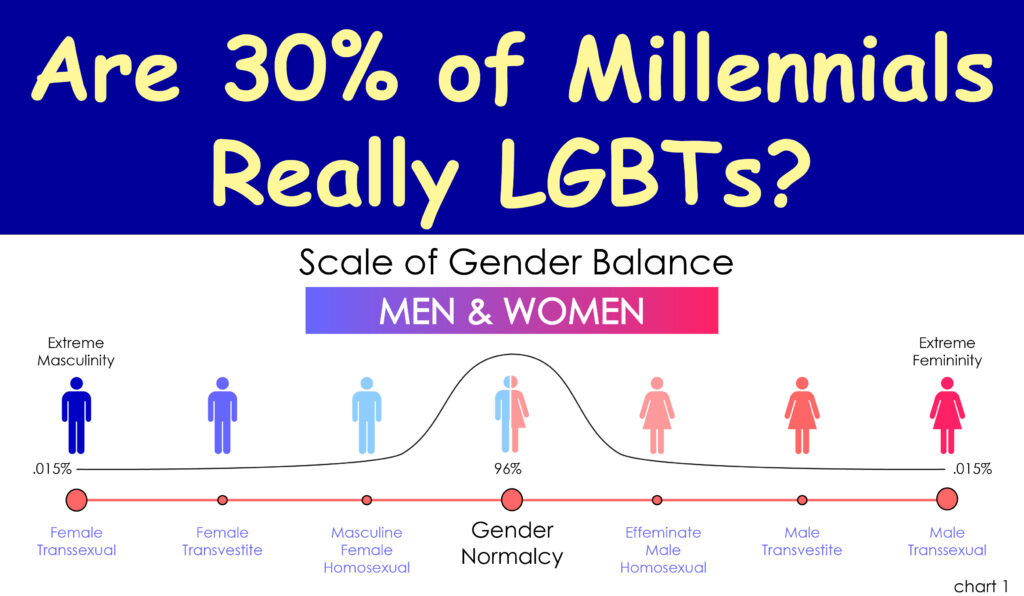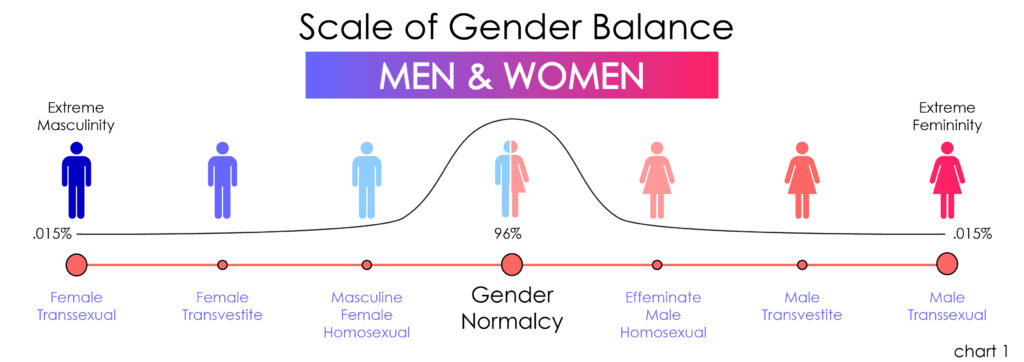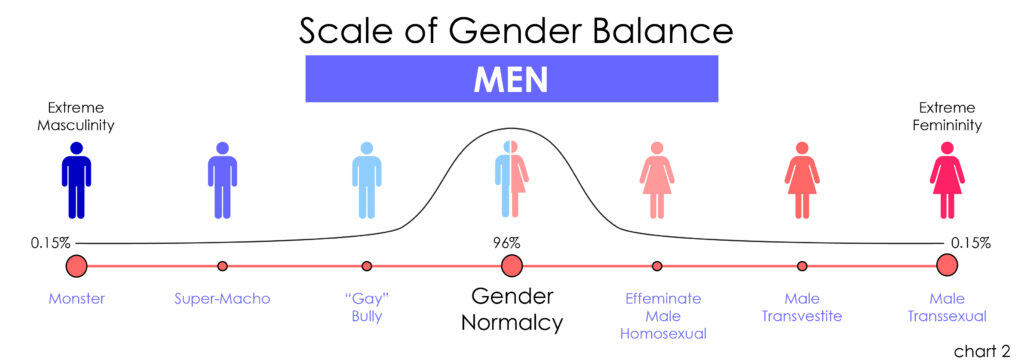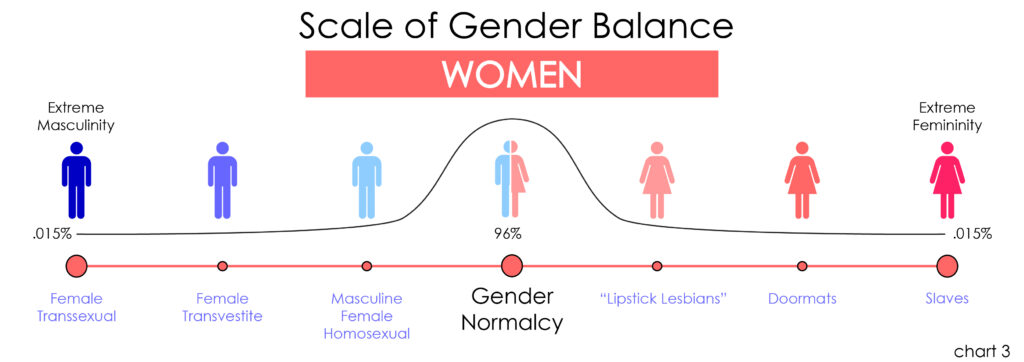
I am not a medical doctor or scientist, but having devoted thirty years of my life to Christian service in the front lines of the culture war I have special insights about our LGBT adversaries collectively, and a deep compassion for the individuals who struggle with same-sex attraction disorder and gender identity confusion.
While the world treats the coalition of lesbian, “gay,” bi-sexual and transgender “sexual minorities” as distinct and separate populations connected only by mutual political interests, I have concluded, on the contrary, that they all suffer from the same common disorder, and these supposedly separate categories are really just degrees of difference on what I call the Scale of Gender Imbalance.
As in all things, the key to true understanding is to seek God’s perspective. On the matters of sexual and gender identity which are so foundational to humanness, God established the One Flesh Paradigm in Genesis 1:27 and 2:24:
“So God created man in his own image, in the image of God created he him; male and female created he them.”
“Therefore shall a man leave his father and his mother, and shall cleave unto his wife: and they shall be one flesh.”
Our sexual and relational physiology and psychology is binary and designed for wholeness through marriage. No doctrine could be more plain and simple than this truth.
But also clear to us from living in these human bodies is the binary nature of our own individual gender identity. The qualities that define both maleness and femaleness are found in each one of us.
And it is obvious by observation of human beings in a group that the balance of gender qualities varies from person to person. The male trait of dominance and female trait of submissiveness, for example, exist in everyone. They, in part, define the difference between men and women generally, but not absolutely. Some men are more or less dominant than other men. Some women are more or less submissive than other women. Some men and women defy the stereotypes entirely.
That varying binary gender balance can be measured on a scale on which the center point represents a perfect balance of maleness and femaleness, and the two poles represent extremes of maleness and femaleness respectively.
Perfect balance is not the norm, nor the goal. Generally speaking, men should and do manifest more masculine than feminine traits, and vice versa for women. But there is a limited range of imbalance that is normal and healthy: measured by the presence of opposite-sex orientation in the psyche of each person. Within this range, are men and women whose gender identity balance is tilted in the wrong direction (men with slightly more femininity than masculinity, and vice versa for women) but who remain within the range of gender normalcy because they still have opposite sex attraction and thus fulfil God’s “One Flesh” design.
I have observed that outside this gender normalcy bubble at the middle of the scale are a small percentage of people whose gender imbalance is abnormal and unhealthy. The further toward the extreme of imbalance in either direction a person falls on the scale, the more abnormal and unhealthy is that person’s sexual and gender identity. In other words, degrees of deviance from the One Flesh design equate to increase in the level of dysfunction.
I have also observed that the percentage of the population that manifests deviance decreases the further you look to the extremes; the full range from pole to pole essentially fits the pattern of a bell curve.
I have created three charts that explain this phenomenon graphically. Chart 1 depicts the phenomenon of male/female gender balance and imbalance generally. Chart 2 shows how gender imbalance in men can explain male homosexuality, transvestitism and transsexualism as degrees of increasing deviance from God’s design. Chart 3 shows the same for women.
Importantly, both men and women can have an overabundance of the gender qualities normal to their sex, which become abnormal when their gender imbalance falls outside the gender normalcy bubble. A woman who is abnormal to a feminine degree just outside the bubble might be classified in street terms as a “lipstick lesbian” in contrast to a “bull dyke” (their terms not mine) whose imbalance skews to the masculine side. Both suffer from same-sex attraction disorder because their imbalance falls outside the bubble of gender normalcy, but one looks feminine and the other looks masculine.
A woman whose imbalance is even more extreme to the side of masculinity will dress and act like a man (transgenderism), and one to the furthest extreme will want to BE a man, even to the point of body mutilation. The same is true of men with an imbalance to the feminine side: manifesting transvestism at the mid-point of the feminine side of the scale and transsexualism at the extreme. Because this is a true scale, a person of either sex can fall anywhere along it, and these categories I am describing are just convenient, familiar designations for illustration purposes.
What causes gender identity imbalance? I have observed three causes in decreasing order of prevalence:
- Sexual abuse in childhood or young adulthood, not necessarily homosexual in nature, but heavily influenced by the gender of the abuser, especially in boys. Lesbianism is, in my view, primarily the consequence of male sexual abuse, triggering a desire to “retreat from the company of men.”
- Trauma-induced gender identity confusion during late infancy/toddlerhood when a child learns to self-identify as male or female by observation and interaction with parents or other primary care-givers. For example, a boy whose Dad is absent or violent may choose to identify with and model his gender identity, including later romantic interests, after Mom. (These are the true-believer “born that way” claimants who have no memories prior to the onset of their disorder and thus assume their condition is innate).
- Rebellion against authority. In the first decades of radical feminism in our culture this category was best represented by “college lesbians,” but today both boys and girls are, in large numbers, being lured into same-sex and “non-binary” self-identification in furtherance of Marxist “social justice” ideology in which heterosexual normalcy and marriage are symbols of “hate” and repression.
How do we help people recover from gender-imbalance disorders? We simply teach and model gender normalcy as a ministry, and urge everyone to seek the balance God designed for us.






